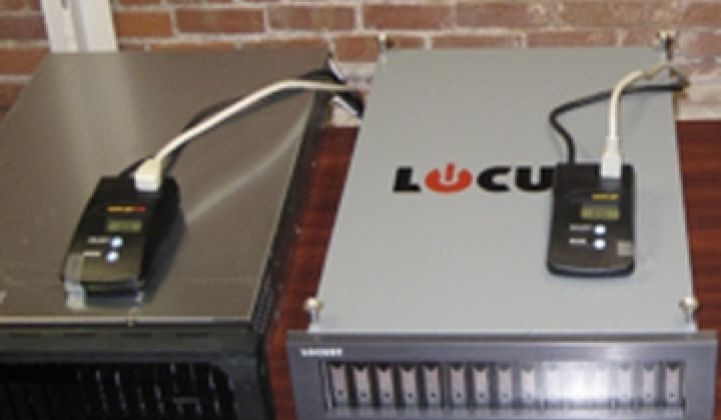It's a data storage system that acts like a solar panel.
San Diego-based Locust Storage is cooking up an energy-efficient data storage device that it says can drastically reduce power consumption in data centers. During slack periods, the device could one day act like an uninterruptible power supply that can deliver electricity, sort of like a solar panel sending power to the grid. A couple of server racks stacked with Locust boxes could return 1.2 kilowatts to the grid.
"We can drive power back to the grid," said CEO Seth Georgion, who spoke at the GreenBeat conference taking place in San Mateo, Calif. Locust also shared the best new startup award at the event. Technically, the storage boxes can't send power to the grid: existing power-over-ethernet standards don't allow it. But it could happen and the company is working with partners to enable it.
The company has built some raw prototypes, but hopes to start getting beta units to customers in the first quarter of next year and, ideally, start selling the devices commercially in the third quarter. So far, it has raised about $500,000
So how does it work? The storage system uses a hybrid model to store data. Data initially gets stored on flash-chips, which are expensive but don't consume nearly as much power as hard drives. By caching data on flash, the disk can be powered down, thereby storing energy. Locust storage systems can reduce power consumption dedicated to storage by 90 percent, the company claims. And storage is gobbling up a larger percentage of the power going to data centers. Storing an exabyte takes 52 megawatts, he said. An exabyte is a billiion gigabytes. A Locust device can store 30 terabytes with 34.4 watts. 20 hours of video are being uploaded to YouTube a minute.
"We have an ability to power the disks down," he said.
Other companies trying to reduce data center power include Sandforce, which has come up with a way to build economical enterprise-class storage systems completely out of flash memory.
Using flash and disks together is not a new idea. Samsung and a number of other hard drive makers have fashioned hybrid drives that combine both types of storage. The price-performance results were middling and customer acceptance, despite lots of hype, barely budged. It is unclear whether Locust uses hybrid drives or buys separate components to make a hybrid device. Either way, the potential to save energy through hybridization makes sense: It all depends on the implementation.
The power savings from keeping the disk largely asleep also lets Locust eliminate fans and other components, which further reduces power consumption.
If Locust can show develop a storage system that in fact can reduce power consumption, it will face another huge hurdle: surviving as a startup in the hardware market. It is a notoriously harsh environment, in part because of tight margins, well-financed incumbents and the manufacturing bills. Blade server companies that emerged with new types of servers in the early part of the decade died a young death after IBM and others got into the market. The companies touting micro-drives largely went away.
Reporter Jeff St. John contributed to this report.



